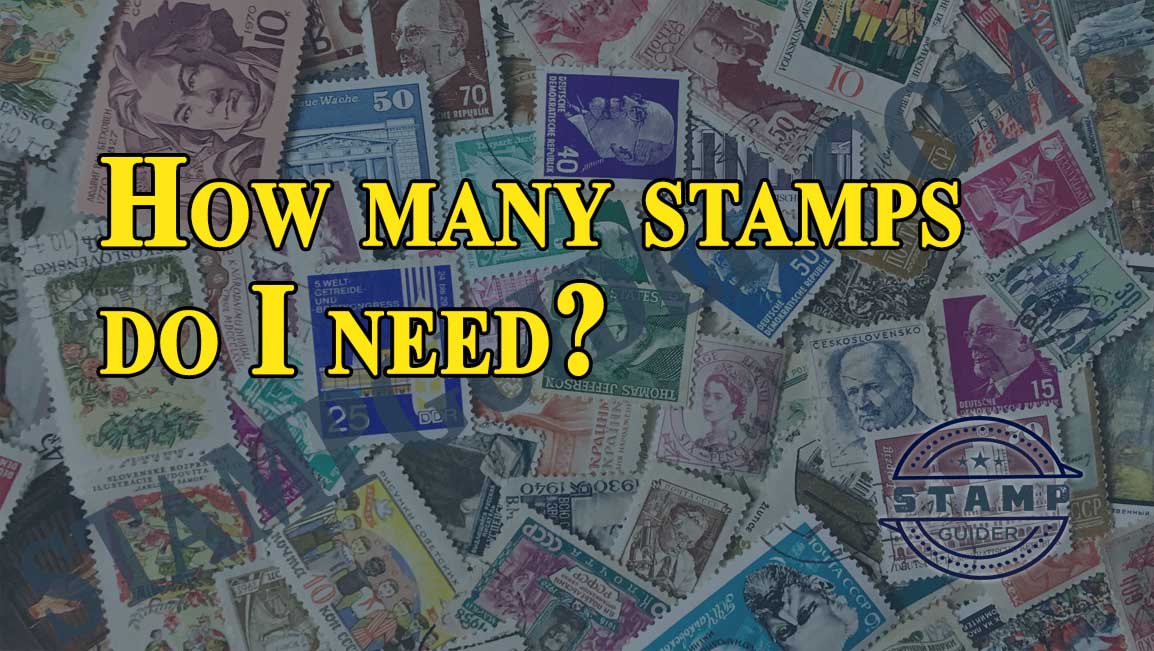Figuring out exactly how many stamps you need to send a package or letter can be a confusing process.
How many stamps do I need: Postage stamps are the little square letters and small packets (in the upper right corner) that tend to be overlooked (and underestimated) recently. As the world continues to move more and more digitally, the lyrics sound strange.
That said, when a person needs to send a letter, envelope or package of parcels, these postage stamps are the key ingredient to make that happen. They play an important role in the shipping of any item, both internationally and nationally.

There are many types of postage stamps. The different stamps differ based on the value of postage, type of shipment, and cosmetic factors (such as design). The actual shipping costs for sending letters and packages vary depending on the weight, height and dimensions of the package and the delivery time. People can choose the shipping style they want based on their delivery time requirements and the volume / metric of the items.
For those unfamiliar with the fundamentals of stamps, here’s a brief introduction:
Table of Contents
About postage stamps
Commonly known as postage stamps, postage stamps are small pieces of paper issued by a post office, postal administration, or other authorized postage stamp vendor in accordance with government rules and regulations. Customers (senders) who wish to send a letter or any other type of package are required to pay a predetermined amount which covers the costs of handling, insuring and registering correspondence. Once the price is determined, the item is affixed with a stamp (on the front or on the side of the address – usually in the upper right corner). The shipment is then processed by postal workers, where a postmark is affixed to the shipment indicating its date and place of origin. This is to ensure that the item is not reused or misused at a later date. At the end of this process, the item is processed and finally delivered to the destination address.
To calculate exactly how many stamps you need, you need to know:
- The size of your letter or package.
- The weight in grams or ounces.
- What class you should send.
- The address to which you are sending your package or letter.
A postage stamp always displays the name of the issuing nation, as well as the denomination of its value. The stamp will also include an illustration of people, events, natural realities or institutions important to the nation in question. The shape of postage stamps tends to vary. Currently, the stamps are rectangular. You can also opt for specialized stamps made to measure according to the issuing post office.
There are several types of tampons available. A complete list of postage stamps available for use is shown below.
- Airmail stamp – For payment for airmail services.
- Booklet stamp – Produced and issued in booklet form.
- Carrier stamp – To deliver mail directly.
- Certified Mail – Provides proof of shipment by way of a receipt to the sender.
- Stamps on Reel – Tear-off stamps issued in vending machines.
- Commemorative stamp – Issued for a limited time to honor a person.
- Computer sold post – advanced secure post.
- Definitive stamps – for daily posting.
- Express courier – Special delivery stamp.
- Local extension – used to send to a local extension.
- Makeup Pad – Small value pad used to make up the difference when patch levels increase.
- Military seal – special postal system for the armed forces of a country.
- Mini sheet – An edition of commemorative stamps, contains a different number of stamps.
- Newspaper Stamp – To pay the cost of sending newspapers and other periodicals.
- Official Postage Stamp – A stamp issued by the government to government agencies.
- Seal of Occupation – Issued for the use of citizens of a country occupied by the forces of a foreign country.
- Unmarked Ports – A stamp that remains valid even when the price of the postage stamp has increased.
- Overprint – A normal stamp, such as a commemorative or definitive stamp, which has been altered after issuance by “imprinting on” portions of the stamp.
- Perforated Joint – Refers to joints with perforations around the joint, called perforations.
- Custom Stamps – Custom stamps that allow the sender to add images of their choice.
- Pneumatic seals – Made only in Italy, these seals are used to ship items by pressurized air tubes.
- Postal Currency – stamps used as currency instead of postage stamps.
- Postage Expired – A stamp indicating that the postage has not been paid.
- Postal Tax – A stamp that indicates that a tax on top of the postage has been paid.
- Self-adhesive pad – Self-adhesive pad.
- Semi-Postal – Also known as a charity stamp, it requires an additional payment to a charity.
- Souvenir Sheet – Contains perforated or non-perforated stamps as part of its design.
- Sample stamp – sent to postal workers to identify valid and counterfeit stamps.
- Test pad – used for testing machines and scanners.
- Variable Value Stamps – Stamps with different rates depending on the time of issue by the machines.
- War Revenue Stamps – A type of revenue stamp that covers the costs of war.
- Water activated pad – generally used, which can be trapped by moisture.
The above list includes most of the available postage stamps. However, for most Americans the main question that always arises is, “How many stamps do I need?” Most people will not need all of the stamps mentioned above. These stamps have sub-genres and their prices and usage vary depending on the type of item being shipped. To provide a more direct answer, here are some specific guidelines on how many stamps you would need at different times.
How many stamps do I need?
For a standard letter
If you are sending a standard letter, a forever stamp or a first class letter stamp can be used in the upper right corner of an envelope. If the letter size is the standard size, a Forever stamp is sufficient for shipping to the United States. The number of stamps to attach to a letter depends on the size and weight of the letter.
For a package
For packages weighing less than 12 ounces (0.75 pounds), one (or more) postage stamps are accepted. The exact number of seals required is calculated based on the weight and size of the package. The point of origin and destination must also be taken into account. Typically, the first four ounces of a package require around $ 3.80 in shipping, with additional shipping added for any additional weight. For more information, see our guide to the cost of first class mail.
For a 9 “by 12” envelope:
The 9 “by 12” envelope is a standard size accepted by postal services. As a standard letter, postage stamps affixed to the upper right corner of the envelope are required for proper postage. For customers with larger envelopes, shipping costs around $ 1.00 for the first ounce and $ 0.20 for each additional ounce.
For a legal size envelope:
Two Forever stamps (currently valued at $ 0.55 per stamp) are required to send a legal size 30 gram envelope (9½ “by 15” envelope). Each additional ounce above the standard of one ounce requires an additional $ 0.20 on shipping costs (based on price increases on January 24, 2021). Large envelopes are typically used to send sheets of legal paper and photos. Large envelopes are also called apartments.
For a Manila envelope:
Manila envelopes have the same postage requirements as 9 x 12 inch and legal size envelopes; the shipping cost is $ 1.00 for the first ounce and $ 0.20 for each additional ounce. If you are using Forever stamps for manila envelopes, you will need two Forever stamps for envelopes weighing less than 30 grams.
For international mail:
a postage stamp called Global Forever is used to send postcards. The same is used for 30 gram letters to be sent anywhere in the world. These stamps can be picked up at the local post office. If you are shipping from the United States, First Class International Mail costs $ 1.20 (Global Forever stamps currently cost $ 1.20). For letters over 1 ounce and packages you will need to do additional calculations based on the weight and dimensions of what you are shipping and the current price of the Global Forever tag to determine the exact price and number of stamps required.
Per ounce:
As we mentioned earlier, the number of stamps to affix to a given mail piece depends on the weight and size of the letter. If the letter to be sent weighs more than 30 grams, you will need to weigh it before affixing the stamps to ensure that the letters are not returned for insufficient postage. The Forever Seal is considered the ideal postage stamp for sending standard one ounce letters to the United States.
Unfortunately, there is no easy answer to the common question: “How many stamps do we need?” However, we hope this article has at least given you a rough idea of how many stamps you would need to send your letter.
Calculate no. of stamps do you need to ship a package?
Calculating the number of stamps needed for a package is a bit more complicated than for cards. Indeed, the shipping costs of the package are invoiced according to the weight and size of the package, as well as the distance traveled.
Packages are usually too large to drop into a mailbox, so you will need to take them to the post office to be shipped, in which case it is easier to ask them to write down the shipping costs for you. However, if you want to know how much to pay or if you want to print your own postage label, you can use the United States Postal Service’s postage calculator.
To use the United States Postal Service postage calculator, follow these steps:
- Enter the destination country in the drop-down list and the zip codes to and from where you are sending the order, along with the date and time of shipment. Also select the appropriate option in the boxes to confirm that you are sending live animals, day-old birds or hazardous materials.
- Select the type of shipment you want to use; Flat rate postcard, flat rate envelopes, flat rate boxes or you can find the price according to the shape and size.
- You will now receive a price for the requested shipping options – select “Show all options” at the top to compare the costs of other shipping options.
- You can then choose to add additional options including shipping certificate, insurance, registered mail, etc.
The next step will show your final shipping costs. - If you haven’t selected any surcharges, you can simply calculate how many stamps you will need to cover the shipping costs. If you added additional options, you will need to print a shipping label at a post office or you can print one yourself through the USPS Click & Ship page.
While in our experience there is always a little wiggle room when weighing a package, it is essential to keep the weight and size of the match in mind. No one wants to send a letter just to get it returned a day later due to lack of proper postage. Usually, the heaviest letters are the most likely to be returned if the mail is not calculated accurately. But with due diligence (if you pay attention to regulations set by the post), you’re always good to go.


